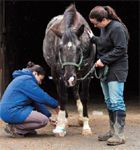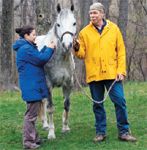Helping the helpless horses
Two New Jersey practitioners earn 2011 Good Works for Horses Award.
Mary Beth Hamorski, VMD, and Christina Wilson, DVM, from Califon Animal Hospital, Califon, N.J., received the American Association of Equine Practitioners (AAEP) 2011 Good Works for Horses Award for their heartfelt work helping Mylestone Equine Rescue care for abandoned, neglected and abused horses.
Nine veterinarians were selected for the Good Works for Horses Award in 2011. As noted by the AAEP, "Throughout 2011, the Good Works for Horses Campaign has highlighted selfless acts of service demonstrated by AAEP members. Equine organizations, rescue facilities and horse owners nominated their veterinarians throughout the year for monthly recognition."
Hamorski and Wilson were honored at the 15th AAEP meeting in San Antonio. With the award, the AAEP will donate $1,000 to Mylestone Equine Rescue in both veterinarians' names, and Pfizer Animal Health will donate $1,000 worth of equine healthcare products.
"For the past 17 years," says the AAEP, "Dr. Hamorski has acted as the veterinary backbone of the rescue, treating horses recovering from complicated medical conditions, including starvation, lameness, founder and the lingering effects of brutality. Dr. Wilson joined Dr. Hamorski's efforts when she was hired at the practice a few years ago and now serves as the primary veterinarian for the rescue."
Susan Kelly Thompson, the president of Mylestone, heard about the Good Works for Horses Award through the AAEP and nominated Hamorski and Wilson for their years of dedicated service to the horses of Mylestone. They provide much of the veterinary services free of charge and all of the veterinary supplies at a discounted rate. In addition, both veterinarians help with fundraising events, host public education events in which they discuss unwanted horses and promote the rescue within their own practice.
"We never thought we would win. There are so many other people doing other good things, too," Hamorski says.
Mylestone Equine Rescue
Mylestone is an equine sanctuary currently housing about 34 needy horses and ponies in Warren County, N.J.
"The rescue takes in horses that no one else wants—horses that would not have a good quality of life elsewhere," Wilson says. "I think that is one of the best things about the rescue. Thompson doesn't necessarily take the horses that would otherwise get homes, but takes those that wouldn't have a chance. Through her connections, she'll re-home many horses without them coming to the farm."
Hamorski, who has been with the rescue since its inception, says, "It was 1995 when Thompson asked me if I wanted to start a horse rescue, so, of course, I said yes. We decided that there would be reduced veterinary fees. Thompson would pay for a visit charge, but she would never have to pay for an exam fee, and we would try to get much of the medications at a reduced cost or contact the drug companies for any short-dated medications that we might be able to use.
"When Mylestone first began, Thompson did not have her own facility. Horses were kept at different farms, so she would make the rounds to the various locations to see how everybody was doing," Hamorski adds.
Over the years, the organization was able to put some money together with the help of donors and through some grant writing, allowing Thompson to buy a small farm in Pohatcong, N.J. Starting with only a few horses, today the rescue facility has grown tremendously.
"Thompson even sold some of her wedding gifts to get the horse rescue up and running and solicited clients via the Christmas newsletter, receiving donations—a wish-list of halters, blankets, treats and other supplies," says Hamorski.
Caring for Mylestone animals
Wilson makes weekly visits to Mylestone and sometimes comes more often to care for the horses. She examines the animals and goes over any issues that need treatment (Photos 1 and 2).

Photo 1: Dr. Christina Wilson changes a bandage on Holly, an 8-year-old Appaloosa mare that is not adoptable as a riding horse because of wobbler syndrome. (Photo courtesy of Rein Photography.)
"Each horse is treated as an individual, on a case-by-case basis. We do whatever is necessary to provide for a good quality of life," Wilson says. "We try our best to rehab them—to find them homes. But, unfortunately, many of them are permanently lame or have serious medical issues that require a special person to adopt them. Most people are not looking to adopt an unhealthy horse, but one they can ride, so some of the horses remain on the farm."

Photo 2: Dr. Christina Wilson vaccinates Jingle, a 15-year-old paint horse that was rescued during the 2009 Christmas season. Jingle has severe bilateral carpal arthritis as well as navicular syndrome. (Photo courtesy of Rein Photography.)
Of the cases that Hamorski and Wilson have worked on recently, a fair amount have involved starvation, especially because of the poor economy. Many people are unable to afford to feed their horses, let alone provide them with medical care.
They also treat lameness issues. "Since such horses are not able to be ridden, other rescue groups may choose to euthanize them, but Thompson puts a fair amount of time, energy and money into improving their quality of life through medical treatment and keeping them at her farm," says Wilson. "They not only live well, but some serve as therapy animals for mentally handicapped children or adults. Thompson works with a local school that serves adults who are mentally handicapped who come once a week, working on the farm, spending a few hours brushing and working with the horses. Mylestone is, therefore, not only helping horses, but is helping people as well."
An example of good works
About 10 years ago, Hamorski got a call from Pam Shell, the local police chief, to meet her at headquarters one Friday night. The police chief said they would have to go out to euthanize three miniature horses because they were in deplorable condition. The owner of the animals had recently passed away, being in and out of the hospital with cancer. Her husband had dementia. Her son would drive to their home to feed these three miniature stallions that were locked in a tool shed in straight stalls, where they could not even turn around.
When Hamorski got there, she expected the worst—and found it. "Their feet were so overgrown that they were touching the ground for a second time," Hamorski notes. "They were skinny and covered with manure. One mini, named Linus—his mane was so long that it reached the ground. When they were brought outside, they were starving for grass, but they all had a sparkle in their eyes, so there was no way I was going to put them to sleep.
"I told the police chief we had to give them a chance," says Hamorski. "So I asked Thompson if we could take them in. We wanted to make sure they were not diseased or affected by parasites. We ended up putting them in a friend's goat shed. I called in a few favors for hoof trimming and food, and we gelded two of them. Linus had a very bad heart condition and was anemic, so we did not geld him. The police chief fell in love with two of them, Amos and Beaner, and adopted them. Linus lived out his years at Mylestone, though he was euthanized this past year well into his late 20s. That's one of my feel-good stories—it ended up good for everyone."
Hamorski emphasizes that as a charity, every penny that is received goes to help the horses at Mylestone. "All of our efforts are to try to make these horses as comfortable as possible," Hamorski says. "Everybody does a little part."
For more information about Mylestone Equine Rescue or to sponsor a horse, visit mylestone.org.
Ed Kane, PhD, is a researcher and consultant in animal nutrition. He is an author and editor on nutrition, physiology and veterinary medicine with a background in horses, pets and livestock. Kane is based in Seattle.
Podcast CE: A Surgeon’s Perspective on Current Trends for the Management of Osteoarthritis, Part 1
May 17th 2024David L. Dycus, DVM, MS, CCRP, DACVS joins Adam Christman, DVM, MBA, to discuss a proactive approach to the diagnosis of osteoarthritis and the best tools for general practice.
Listen